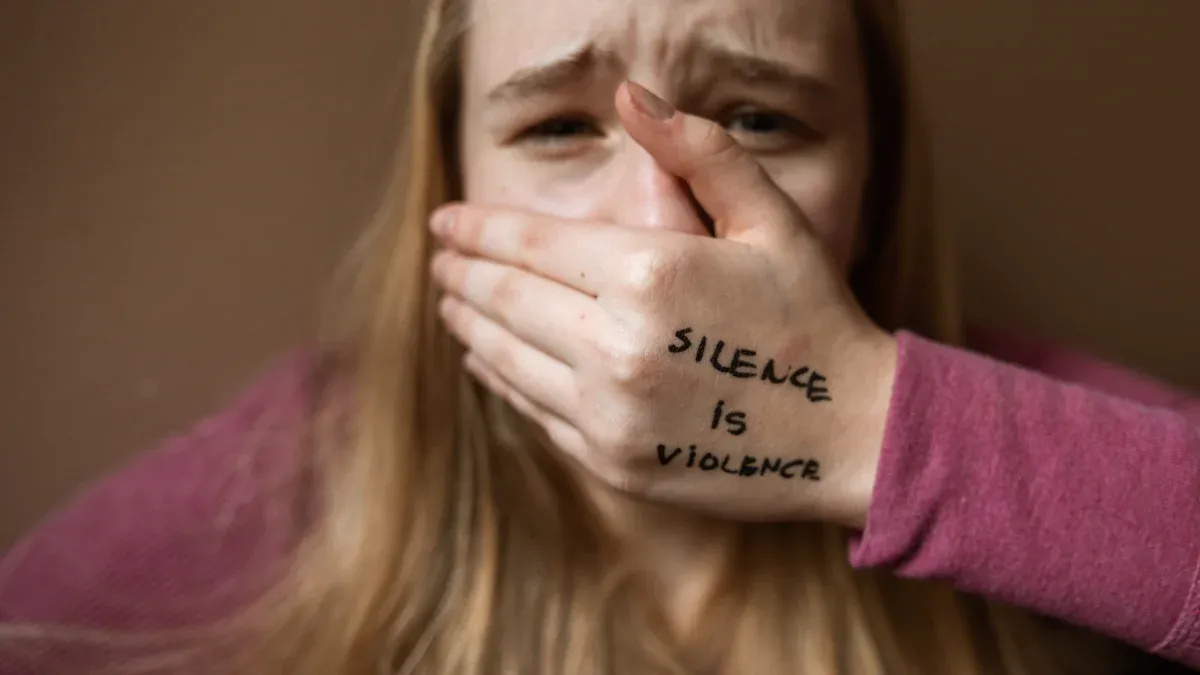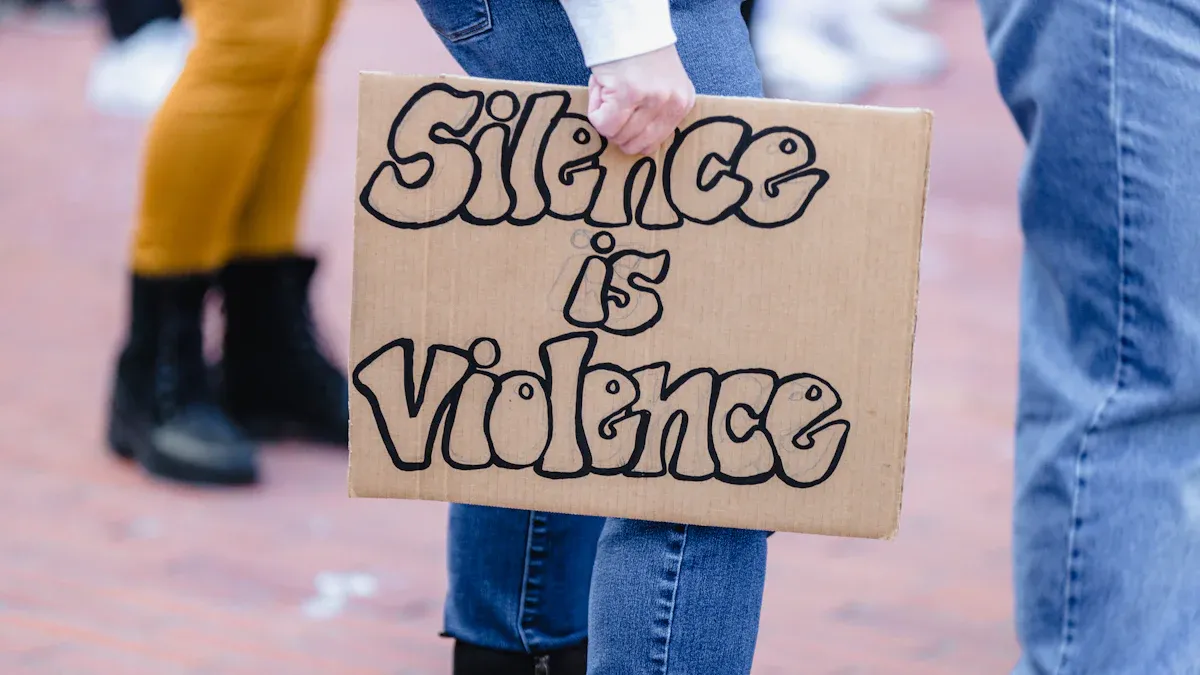Domestic Violence Awareness Month: Tips for Families and Friends

You have an important job in helping someone with domestic violence. Many people in the United States are hurt each year. More than 10 million men and women are victims every year. Your help can really change things. About 35% of survivors say family and friends helped them leave abuse. Domestic Violence Awareness Month shows your care is important. Think about how you can help keep others safe and help them heal.
Key Takeaways
October is Domestic Violence Awareness Month. Take this time to learn about abuse signs. Teach others about these signs too.
Notice the signs of domestic violence. Look for physical and emotional clues. Being aware can help someone who needs it.
Support survivors by listening to them. Do not judge them. Your support can help them feel stronger. It may help them get more help.
Help someone make a safety plan if they face abuse. This plan gives important steps to stay safe. It helps in dangerous times.
Join community events in October. Being involved helps spread awareness. It also shows you care about survivors.
October Is Domestic Violence Awareness Month
History and Purpose
You might wonder when domestic violence awareness month started. The National Coalition Against Domestic Violence began this movement in 1981. The first event was called the Day of Unity. People wanted to help survivors and talk about gender-based violence. After six years, October 1987 became the first official domestic violence awareness month. In 1989, Congress passed Public Law 101-112. This law made October the national domestic violence awareness month. The campaign grew from one day to a whole month. Grassroots advocacy helped make dvam a national focus.
The Day of Unity began in 1981. By 1987, it became domestic violence awareness month. Congress made it official in 1989.
Why October Matters
October is domestic violence awareness month. You help by raising awareness and supporting survivors. DVAM helps communities learn and take action. October is a time to honor survivors and learn about domestic violence. Many groups use dvam to share resources and hold events. You can join these activities and help others understand why support is needed. Sometimes, things like government shutdowns make it hard for survivors to get help. This makes dvam 2025 even more important. Your voice and actions matter in October. You help show why resources and safety are needed. Domestic violence awareness month asks you to stand with survivors and push for change.
You can teach others about domestic violence.
DVAM shows why community support is needed.
You help honor survivors and support healing.
Recognizing Signs

It is important to know the signs of domestic violence. This helps you support someone who needs help. Many people hide what is happening to them. You can help by learning what signs to look for. You can also learn how to respond.
Physical and Emotional Clues
You might see changes in how someone looks or acts. Some signs are easy to notice. Other signs are hard to see. Look at the table below to learn about common clues:
Type of Sign | Examples of Signs |
|---|---|
Physical Signs | black eyes, bruises on arms, sprained wrists, broken bones, unexplained pain |
Emotional Signs | increased anxiety, irritability, low self-esteem, fearfulness, lack of interest in activities, fatigue, increased crying, suicidal ideation |
A victim may wear long sleeves even when it is hot. They might stay away from social events. You could see them become quiet or pull away from others. These clues can show that something is wrong.
Behavioral Changes
People often act differently when they face abuse. You may notice your loved one:
Stops hanging out with friends or family
Cancels plans a lot or at the last minute
Acts nervous when their partner is near
Checks in with their partner often or asks for permission
Has sudden changes in mood or personality
Becomes secretive about their home life

Detect Manipulation in Conversations
Use AI-powered tools to analyze text and audio for gaslighting and manipulation patterns. Gain clarity, actionable insights, and support to navigate challenging relationships.
Myths
Many myths about domestic violence make it hard to help. These myths can stop you from seeing what is really happening. Here are some common myths and facts:
Myth | Explanation |
|---|---|
Domestic Violence Only Involves Physical Abuse | It includes psychological, emotional, sexual, and financial abuse, which can be equally damaging. |
Domestic Violence Is a Private Family Matter | This misconception discourages intervention and isolates the victim, making it a societal issue. |
Victims Can Easily Leave Abusive Relationships | Leaving is often dangerous and complex due to various barriers. |
Domestic Violence Only Happens in Certain Demographics | It can affect anyone, regardless of socio-economic status, race, age, or gender. |
Domestic Violence Is Always Obvious to Outsiders | Many victims hide their abuse, making it difficult for others to detect. |
You might hear people say things like:
If it was that bad, she would leave.
Domestic abuse always means physical violence.
Alcohol and drugs make men more violent.
These ideas are not true. Abuse can be emotional or about money. Leaving is not always easy or safe. The person who hurts others is responsible for their actions, not drugs or alcohol.
How to Approach Concerns
If you think someone you care about is facing domestic violence, you can help. Experts suggest these steps:
Think about safety for everyone.
Stay away from places where the abuser can scare or control.
Listen to all concerns and claims fairly.
Notice the strengths and needs of each parent and their relationship with children.
Look at all the facts before making choices.
Remember safety risks and help with healing from trauma.
Notice how domestic violence affects children’s feelings and thoughts.
You can also:
Ask why someone wants visits or contact with the abuser.
Make sure visits are safe for kids and the abused parent. Sometimes, supervised visits are best.
Note: Your support can help a victim feel less alone. You do not have to fix everything. Listening and believing them is a strong first step.
Emotional Support
You are important when helping someone with domestic violence. Survivors need safety and support. Your help can make them feel less alone. You do not have to fix every problem. You can listen and respect their boundaries.
Listening
Listening is very helpful for survivors. You help them feel heard. Counselors suggest these tips:
Pay attention. Look at them and show you care.
Do not interrupt or give advice unless asked.
Let them talk about their feelings.
Ask open questions if they feel okay.
Say things that show you understand.
Tip: Sometimes, sitting quietly and letting them talk helps.
Validating
Validation means you believe their story and feelings. You help them feel respected. When you validate, they may ask for more help. Studies show validation helps them reach out for support.
| Evidence Type --- Findings | |--------------- -------------| | Help-Seeking Propensity --- Higher scores in help-seeking propensity are linked to greater intentions to seek professional help. | | PTSD Impact --- PTSD symptoms can hinder engagement in professional treatment. | | Depression Impact --- Depression may deter help-seeking due to its debilitating effects. |
You can say things like:
"I believe you."
"You did not deserve this."
"Your feelings matter."
"You are not alone."
Note: Survivors need support. Your words can help them feel safe.
Respecting Boundaries
Respecting boundaries helps survivors feel in control. You show you care about their choices. Experts suggest these ideas:
Give loving support. Spend time or send messages. Remind them they decide for themselves.
Encourage self-care. Help them find ways to feel better.
Make a safety plan together if they want.
Listen and support their choices. Do not tell them what to do.
Encourage small steps. Help them feel safer.
Take care of yourself too. Helping can be hard.
Remember: Survivors need solidarity. You help by respecting their wishes.
You can build a strong support network. Join groups or talk with friends. Learn about healthy boundaries and self-care. You help survivors learn about their rights and choices.
Safety
Safety Plans
You can help someone stay safer by working together on a safety plan. A safety plan is a tool that helps a victim think about what to do in dangerous situations. It covers steps to take at home, work, and in public. Each plan should fit the person's life and needs. Look at the table below for important parts of a good safety plan:
Component | Description |
|---|---|
Risk Assessment | Check the level of danger and spot specific risks. |
Home Security Measures | Use locks, alarms, or other ways to make the home safer. |
Changing Social Habits | Change routines and places to avoid being found by the abuser. |
Workplace Safety | Tell employers and adjust work settings for more safety. |
Considerations for Children | Teach children how to get help and what to do in emergencies. |
Personal Supports and Skills | Build a support network and learn ways to handle stress and anxiety. |
A safety plan helps a victim look at problems in their relationship and find ways to stay safe. It should cover different situations and give steps to lower the chance of harm.
When to Intervene
You play a key role in helping someone who faces domestic violence. Friends and family often help a victim feel safe enough to talk about abuse. Your support can improve their health and well-being. You should step in when:
The person asks for help or shares their story.
You see signs of danger or fear for their safety.
Children are at risk or in harm’s way.
The person cannot reach out for help on their own.
Positive support from you can help the victim seek help and feel less alone, especially for those who may not have many resources.
Reducing Risk
You can help lower the risk of harm by using smart strategies. Survivors often use signals with their children, like a special word or gesture, to show when to hide or leave. Talking often about safety and exit plans helps everyone know what to do. You can also help by:
Encouraging activities outside the home, like going to the library or joining clubs.
Helping the person build a support network with friends, neighbors, or community groups.
Reminding them to keep important documents and emergency contacts ready.
Tip: Ongoing planning and open talks about safety help everyone feel more prepared and less afraid.
Resources
There are many places that help people facing domestic violence. These places give support, safety, and hope. Knowing where to go can really help.
Helplines
Helplines let you get help fast, day or night. You can call, text, or chat online. Most helplines keep your information private. They connect you with local help. Here are two national helplines you can use:
Helpline Name | Services Provided | Contact Information |
|---|---|---|
National Domestic Violence Hotline | 24/7 confidential support, crisis intervention, educational services, referral services, safety planning | Phone: 1-800-799-7233, Text: LOVEIS to 22522, Online Chat: Visit |
StrongHearts Native Helpline | Culturally-appropriate support for Native Americans, crisis intervention, peer support, advocacy | Phone: 1-844-7NATIVE, Online Chat: Visit |
Tip: Put these numbers in your phone. You can share them fast.
Support Services
Support services help survivors feel safe and hopeful. You can find shelters, counseling, and support groups nearby. Many groups offer these for free. Here are some common support services:
Shelters give a safe place to stay.
Advocacy services help you with tough problems.
Support groups help you feel less alone.
Counseling helps you heal and handle stress.
Many survivors say these services make them feel stronger. You can also look for a domestic violence program in your area.
Legal Help
Legal help keeps you safe and protects your rights. You can get help with protective orders, child custody, and divorce. Some programs have free legal clinics or connect you with lawyers. Here are some legal resources:
Legal Resource | Description | Typical Outcomes |
|---|---|---|
Satellite Attorney Program | Gives legal help for survivors in Indiana. | Better results with protective orders and family law issues. |
Legal Crisis Assistance | Offers quick legal advice and help. | More access to legal help and less trauma. |
Pro Se Legal Clinics | Monthly clinics help you represent yourself in court. | More confidence and knowledge for self-representation. |
You can ask local advocates or a domestic violence program for legal help. Many groups work together to make sure you get the support you need.
Domestic Violence Awareness Month Activities

Educate
You can teach others about domestic violence in October. First, learn the signs of abuse yourself. Talk with your family about what you know. Share facts and stories from your community. Many groups use October to help people learn and ask for better laws. You can:
Read articles or watch videos about domestic violence.
Tell your friends what you learned.
Join online workshops or webinars.
Speak up for better laws and more help for survivors.
Tip: Learning helps you notice abuse and help people who need it.
Community Events
Communities have special events in October. These events help people learn and support survivors. You can join things like panel talks, training, and wearing purple. Here are some events and what they do:
| Event Type --- Description --- Impact | | National Call for Unity --- Black women survivors and advocates share their voices. --- Raises awareness about racial justice for survivors. | | Coffee and Conversation --- Panel talk about Black queer survivors. --- Gives a place for support and sharing. | | Purple Thursday --- People wear purple to honor survivors. --- Shows support and brings people together. | | Bystander Intervention Training --- Webinar teaches how to stop street harassment. --- Helps people learn to take action. |
You can also:
Go to workshops, candlelight vigils, or forums near you.
Share a picture of yourself wearing purple on Purple Thursday.
Join fundraising events like GiveForDV.
Share Information
Sharing helps others learn about domestic violence. Use social media to spread messages and stories in October. Always respect what survivors want and keep their privacy. When you share, remember:
Trust what survivors say and let them lead.
Remind people that domestic violence is not just a family problem.
Listen and support without making anyone share their story.
Note: Sharing the right way keeps survivors safe and helps your community learn.
You help by teaching, joining events, and sharing in October. Your actions raise awareness and support survivors.
You help someone by listening and giving support. You can also share helpful resources. Studies show that caring lowers the chance of more harm. It also helps people heal. When you keep helping, survivors get stronger. They also find it easier to get help.
| Action --- Impact | | Listening --- Helps people feel better and healthier | | Community involvement --- Makes things safer for everyone |
Keep helping in October and after. Go to local events and wear purple. Share what you learn with others. What you do matters every day.
Help survivors
Speak up for change
Make your community safer
“Healing takes time and can change like the weather. Some days are hard, but happy memories help. I hope as I get older, good moments will cover the pain I feel each day.”
FAQ
What should you do if someone tells you about abuse?
Listen without judging. Tell them you believe them. Offer support and ask what they need. Do not pressure them to take action. Let them know about helplines and resources.
How can you help if you think someone is in danger?
If you see signs of danger, call 911. Safety comes first. You can also help them make a safety plan. Share emergency contacts and encourage them to reach out for help.
Can you talk to the abuser to stop the violence?
You should not confront the abuser. This can put you and the victim at risk. Focus on supporting the person facing abuse. Encourage them to seek help from professionals.
How do you support someone who does not want to leave?
Respect their choices. Leaving can be hard and unsafe. Stay connected and offer help when they ask. Remind them you care and will support them whenever they are ready.
What resources can you share with someone experiencing domestic violence?
You can share the National Domestic Violence Hotline (1-800-799-7233), local shelters, and counseling services. Give them information in a safe way. Let them decide when to use it.